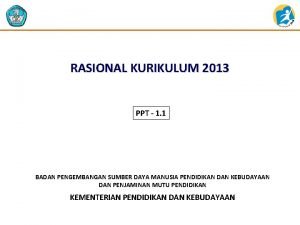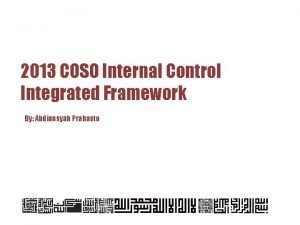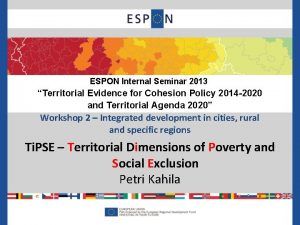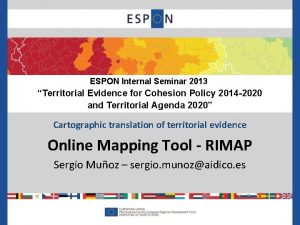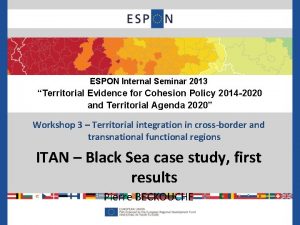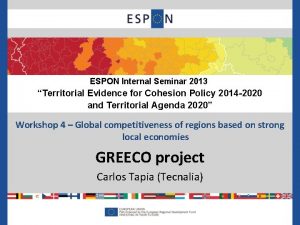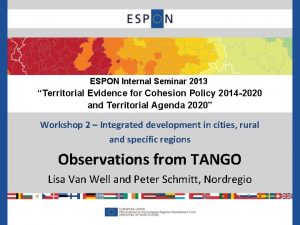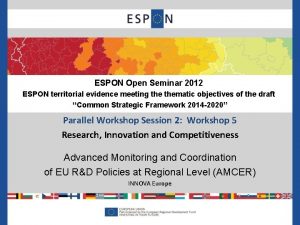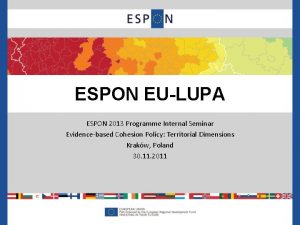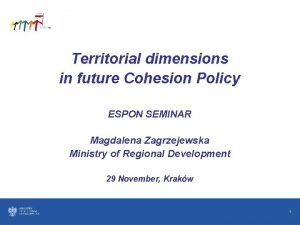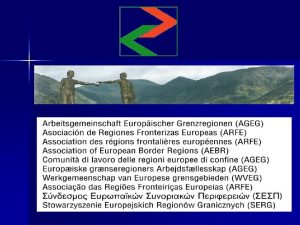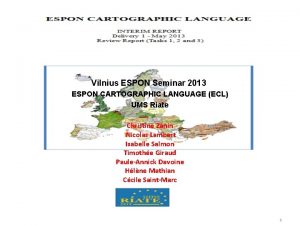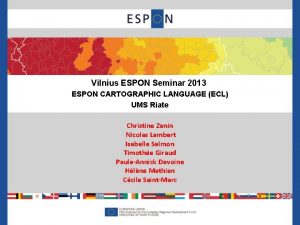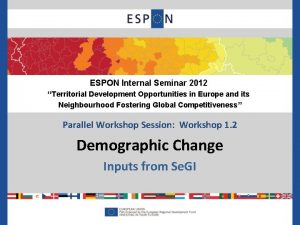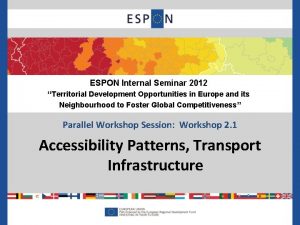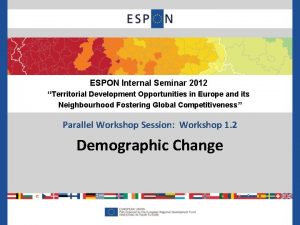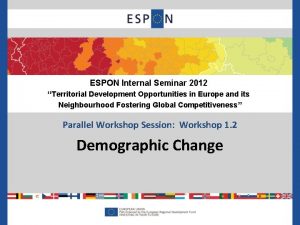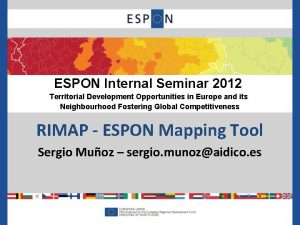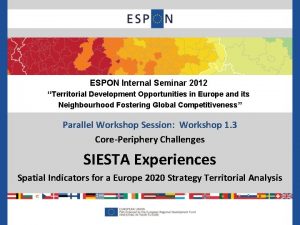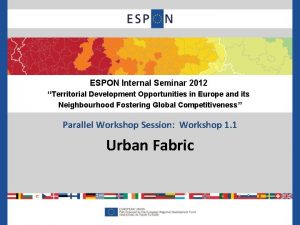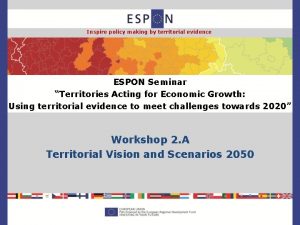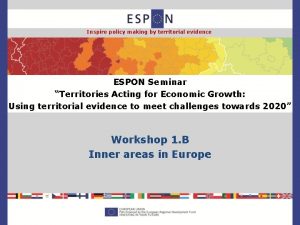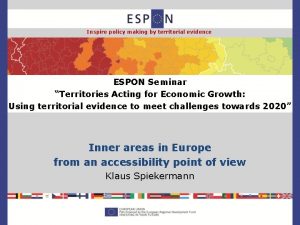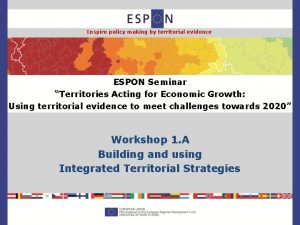ESPON Internal Seminar 2013 Territorial Evidence for Cohesion

































- Slides: 33

ESPON Internal Seminar 2013 “Territorial Evidence for Cohesion Policy 2014 -2020 and Territorial Agenda 2020” 4 -5 December 2013 Vilnius, Lithuania ESPON BSR Te. Mo Gunnar Lindberg, Nordregio

TPG

What we have built: BSR Territorial Monitoring (Te. Mo) system Policy dimension Methodological dimension - An operational indicatorbased territorial development monitoring system, comprehending a policy and a methodological dimension aimed at understanding territorial cohesion in the Baltic Sea Region.

Added value of Te. Mo - Building on regional policy context - Addressing the policy questions that are important in the region; - the context of the region and stakeholders is really strong. - Using available data, and at NUTS 3. - We have the data – and we show also how to measure territorial cohesion. - With 10 operational analytical indicators

Target Group • Analysts and practitioners working with policy makers responsible for cohesion, regional and spatial policy; • International organizations (e. g. the VASAB-cooperation and the HELCOM organization), and local cross-border associations (i. e. Euroregions); • The ESPON community (including stakeholders, researchers and planners); • Institutions implementing, managing and evaluating actions taken within the framework of the EU’s cohesion policy; • Researchers dealing with territorial cohesion; • Other interested actors, including students.

Geographical coverage NUTS-3 and NUTS-2 levels are identified as the main geographical scales to work at in ESPON Te. Mo. The task for BSR Te. Mo was to generate seamless layers of administrative boundaries (NUTS 3, NUTS 2 and NUTS 0) for the study area including Belarus and Russia. The project attempts to find additional data at the LAU-2 level.

Thematic content and indicators Policy and Theory - Concept of territorial cohesion (TC) - BSR “filter” on TC - Monitoring experiences - Previous indicators Workshop - 7 domains - No sub-domains - Focus on linking up with BSR topics - No indicators Final system - 5 Domains - 12 sub-domains - At first ca 90 indicators - Now 29 indicators

Structure of Te. Mo


10 Analytical / Complex indicators (1. ) The Gini Concentration Ratio (2. ) The Atkinson index Distribution (3. ) The 80/20 ratio (4. ) Sigma-convergence Convergence (5. ) Beta-convergence (6. ) The east/west ratio (7. ) The south/north ratio (8. ) The urban/rural ratio (9. ) The non-border/border ratio (10. ) The coast/inland ratio Targeted/Territorial

Application of the System Testing of the monitoring system: allowed to establish the functionality of the system by pushing its analytical capacity in a selection of “real life situations”. Investigative areas (topics): • • ability to handle cross-cutting issues (territorial cohesion); functionality within a pronounced thematic focus (migration); functionality to depict a particular geographic scope (border regions); overall benchmarking ability (BSR benchmarked against the Alpine Space and the North Sea transnational regions). Example of results on territorial cohesion: Population with tertiary education

Migration: Migration is primarily directed towards urban regions of the BSR. The financial crisis also appears to have affected rural migration harder than any other type of regions (next slide)

Migration: trends 2005 -2010

Migration: the story of jobs

Migration: the story of factors

Main development trends of BSR The main BSR divides: • East-West (between more and less affluent countries); • North-South (between countries with low and high population density); • Urban-rural (between rural and urban areas).

The Principal Divides (1): East-West Between more and less affluent countries: the sharpest divide today can be found within the social spheres of development. In terms of for instance poverty or health, the BSR displays a substantial variation.

The Principal Divides (2): North-South Between countries with low and high population density: sparse regions are in general the most disadvantaged types of territories and are largely lagging behind in most aspects of socioeconomic development, particularly when examined in a national context.

The Principal Divides (3): Urban–Rural Between rural and urban areas: with very few exceptions the rural areas generally occupy the bottom positions regarding most aspects of socio-economic development. The financial crisis also appears to have affected rural migration harder than any other type of regions.

The Principal Divides (3): Urban–Rural Between rural and urban areas: Although there is still a divide between East and West, - Some of the most pronounced disparities in GDP/capita can be found between urban/rural areas – rather than between countries.

Benchmarking • The BSR has far outperformed its peer regions in economic growth primarily due to the rapid catch- up of eastern BSR. • Despite rapid catch-up, the material welfare gap of the BSR is still in a league of its own compared to the peer regions. • The BSR is inaccessible in comparison to peer regions, but gradually gaining in on them. • The BSR on the whole is not as attractive to migrants as its peer regions. • The BSR lags behind its peer regions in the general health status of its population. • Interregional differences in the BSR are pronounced in comparison. • The air quality of the BSR appears not markedly different from that of its peer regions. However, no comparable data on the non-EU parts of the BSR are available.

Benchmarking

Benchmarking

Comparison with EU territory

Comparison with EU territory

Visualisation Ø Have taken into consideration the wishes of stakeholders w. r. t. - Methods of analysis - Concepts for visualization (types of maps etc. ) Ø Tries to reflect on what is missing in previous monitoring systems when it comes to visualization and final use of results (e. g. INTERCO). Ø One idea was to develop a simple tool which could simplify the access to the indicators and the analysis.

Presentation Tool: http: //bsr. espon. eu






Thank you!
 Www.espon
Www.espon Tantangan internal dan eksternal kurikulum 2013
Tantangan internal dan eksternal kurikulum 2013 Coso 2013 cube
Coso 2013 cube Internal control images
Internal control images A pair of latex gloves was found at a crime scene
A pair of latex gloves was found at a crime scene Primary evidence vs secondary evidence
Primary evidence vs secondary evidence Fiber evidence can have probative value as class evidence.
Fiber evidence can have probative value as class evidence. Genetic fallacy definition
Genetic fallacy definition Secondary sources
Secondary sources Class evidence vs individual evidence
Class evidence vs individual evidence Primary evidence vs secondary evidence
Primary evidence vs secondary evidence Explain how class evidence can have probative value
Explain how class evidence can have probative value What is a primary source
What is a primary source Primary evidence vs secondary evidence
Primary evidence vs secondary evidence Jewish translation
Jewish translation System of internal controls
System of internal controls Audit report of a company
Audit report of a company Redogör för vad psykologi är
Redogör för vad psykologi är Gumman cirkel sång
Gumman cirkel sång Bästa kameran för astrofoto
Bästa kameran för astrofoto Dikt fri form
Dikt fri form Ledarskapsteorier
Ledarskapsteorier Svenskt ramverk för digital samverkan
Svenskt ramverk för digital samverkan Kvinnlig mantel i antikens rom
Kvinnlig mantel i antikens rom Tidbok för yrkesförare
Tidbok för yrkesförare Iso 22301 utbildning
Iso 22301 utbildning Orubbliga rättigheter
Orubbliga rättigheter Big brother rösta
Big brother rösta Ministerstyre för och nackdelar
Ministerstyre för och nackdelar Sju principer för tillitsbaserad styrning
Sju principer för tillitsbaserad styrning Bat mitza
Bat mitza Boverket ka
Boverket ka Nyckelkompetenser för livslångt lärande
Nyckelkompetenser för livslångt lärande Romarriket tidslinje
Romarriket tidslinje

